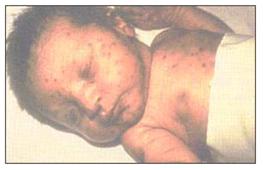선천성 풍진 증후군 Congenital rubella syndrome
■ 선천성 풍진 증후군의 원인
풍진백신 접종을 과거에 한 번도 맞지 않았거나 풍진을 한 번도 앓은 적이 없어 풍진바이러스 감염에 면역이 없는 임신부가 임신 첫 3개월 간(임신 1기) 풍진을 앓을 때 태아에게 풍진 바이러스 감염이 생겨 태아에게 풍진이 생길 수 있다.
[부모도 반의사가 되어야 한다– 소아가정간호백과]-제2권 소아 청소년 아이들의 질병과 안전사고의 예방–풍진 예방접종, 제7권 소아 청소년 감염병, 제 25권 임신, 분만, 출산, 신생아 돌보기–풍진 참조.
태아가 자궁 내에서 풍진에 걸리면 특히 제1 3개월기 임신 중 여러 종류의 선천성 기형이 태아에게 생길 수 있다. 그 풍진을 선천성 풍진 증후군이라고 한다.
선천성 풍진 증후군이 있으면 신생아에게 농아, 백내장, 소두증, 심장 기형 등 여러 가지 선천성 기형이 생길 수 있다.

사진226.선천성 풍진 증후군
참조문헌-CDC, USA
■ 선천성 풍진 증후군의 증상
선천성 풍진 증후군의 증상은 다양하고 전형적인 증상은 다음과 같다.
심한 선천성 풍진 증후군에 걸린 태아의 성장 발육이 지연되고 낙태되거나 유산이 될 수 있다.
선천성 풍진 증후군에 걸린 태아가 출생하면 신생아의 눈이 멀거나, 귀가 먹기도 하고, 심장 기형이 생길 수 있다.
태어난 후 신체 여러 계통의 여러 기관에 여러 종류의 선천성 기형이 신생아에게 생길 수 있고 혈소판 감소증도 생길 수 있다.
신생아의 간, 지라, 임파선 등이 부을 수 있다.
그 외 소두증, 성장 발육 지연, 지능저하, 학습 장애 등의 증상 징후도 생길 수 있다.
■ 선천성 풍진 증후군의 진단
병력, 증상 징후, 진찰소견 등을 종합해서 진단할 수 있다.
임신 첫삼 3개월기 동안 임산신부가 풍진을 앓은 경험이 있으면 선천성 풍진 증후군을 진단하는데 아주 중요한 단서가 될 수 있다.
신생아의 인두 점액, 소변, 뇌 척수액 등에서 얻은 피 검물로 풍진 바이러스를 배양해서 확진할 수 있다.
풍진바이러스 혈중 항원, 항체 검사를 해서 진단하기도 한다.
■ 선천성 풍진 증후군의 치료
선천성 풍진증후군의 치료하는 특효약도 없고 특별한 치료도 없다.
여러 가지 선천성 기형으로 인한 증상 징후에 따라 대증치료 한다.
Congenital rubella syndrome 선천성 풍진 증후군
■ Causes of congenital rubella syndrome
A pregnant woman who has not been vaccinated against rubella in the past or who is not immune to rubella virus infection because she has never been vaccinated against rubella in the first 3 months of pregnancy (first trimester).
Rubella can develop.www.drleepediatrics.com-Volume 2 Prevention of diseases and safety accidents in children and adolescents-Rubella vaccination, Volume 7 Infectious diseases of children and adolescents, Volume 25 Pregnancy, childbirth, childbirth, care for newborns -See Rubella. If the fetus gets rubella in the womb, several types of birth defects can develop in the fetus, especially during the first trimester. The rubella is called congenital rubella syndrome. With congenital rubella syndrome, newborns can develop a number of congenital anomalies, including deafness, cataracts, microcephaly, and heart malformations.

Picture 226. Congenital rubella syndrome References-CDC, USA
■ Symptoms of congenital rubella syndrome
Symptoms of congenital rubella syndrome are diverse and typical symptoms are as follows. Fetuses with severe congenital rubella syndrome may delay growth and lead to abortion or miscarriage.
The birth of a fetus with congenital rubella syndrome can lead to blindness, deafness, and heart malformations in the newborn. After birth, newborns can develop several types of birth defects in various organs of the body, and thrombocytopenia can also occur. The newborn’s liver, spleen, and lymph nodes may swell. In addition, symptoms such as microcephaly, delayed growth and development, decreased intelligence, and learning disabilities may also occur.
■ Diagnosis of congenital rubella syndrome
It can be diagnosed by combining medical history, symptom signs, and examination findings. The experience of a pregnant bride with rubella during the first trimester of pregnancy can be a very important clue in diagnosing congenital rubella syndrome. It can be confirmed by culturing the rubella virus with specimens obtained from newborns’ pharyngeal mucus, urine, and cerebrospinal fluid. Rubella virus blood antigen and antibody tests are also diagnosed.
■ Treatment of congenital rubella syndrome
There are no special drugs to treat congenital rubella syndrome and no special treatment. Symptomatic treatment is performed according to the symptoms and signs of various congenital anomalies.
출처와 참조 문헌 Sources and references
- NelsonTextbook of Pediatrics 22ND Ed
- The Harriet Lane Handbook 22ND Ed
- Growth and development of the children
- Red Book 32nd Ed 2021-2024
- Neonatal Resuscitation, American Academy Pediatrics
- www.drleepediatrics.com제6권. 신생아의 성장 발육 양육 질환
- The Johns Hopkins Hospital, The Harriet Lane Handbook, 18th edition
- Red book 29th-31st edition 2021
- Nelson Text Book of Pediatrics 19th-21st Edition
-
Childhood Emergencies in the Office, Hospital and Community, American Academy of Pediatrics
-
Emergency Medical Service for Children, By Ross Lab. May 1989. p.10
-
Emergency care, Harvey grant, and Robert Murray
-
Emergency Care Transportation of Sick and Injured American Academy of Orthopaedic Surgeons
-
Emergency Pediatrics A Guide to Ambulatory Care, Roger M. Barkin, Peter Rosen
-
Immediate care of the acutely ill and injured, Hugh E. Stephenson, Jr
-
The Critically Ill Child, Diagnosis and Management, Edited by Clement A. Smith
-
Emergency Medical Services for Children: The Role of the Primary Care Provider, America Academy of Pediatrics
-
Quick Reference To Pediatric Emergencies, Delmer J. Pascoe, M.D., Moses Grossman, M.D. with 26 contributors
-
Manual of Emergency Care 응급환자관리 정담미디어
-
소아가정간호백과–부모도 반의사가 되어야 한다, 이상원
-
Neonatal Resuscitation American heart Association
-
Neonatology Jeffrey J.Pomerance, C. Joan Richardson
-
Pediatric Resuscitation Pediatric Clinics of North America, Stephen M. Schexnayder, M.D.
-
Pediatric Critical Care, Pediatric Clinics of North America, James P. Orlowski, M.D.
-
Preparation for Birth. Beverly Savage and Dianna Smith
- Infectious disease of children, Saul Krugman, Samuel L Katz, Ann A. Gershon, Catherine Wilfert
-
The Harriet Lane Handbook 19th Edition
-
소아과학 안효섭 외 대한교과서
-
제1권 소아청소년 응급의료 참조문헌과 출처
-
Other
Copyright ⓒ 2014 John Sangwon Lee, MD., FAAP
“부모도 반의사가 되어야 한다”-본 사이트의 내용은 여러분들의 의사로부터 얻은 정보와 진료를 대신할 수 없습니다.
“The information contained in this publication should not be used as a substitute for the medical care and advice of your doctor. There may be variations in treatment that your doctor may recommend based on individual facts and circumstances.
“Parental education is the best medicine.“